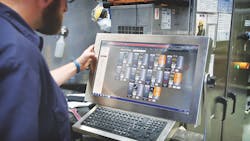Keys in Ignition
About the author: Jim Meyers is success manager for Inductive Automation. Meyers can be reached at [email protected].
Stone Brewing is the ninth largest craft brewery in the U.S. and is growing larger. Based in San Diego and founded in 1996, Stone Brewing added new facilities in Richmond, Va., and Berlin, Germany, in 2016. To run its main brewery in Escondido, Calif., Stone uses Ignition by Inductive Automation for supervisory control and data acquisition (SCADA) and for its manufacturing execution system (MES).
Ignition is an industrial application platform with several tools for creating solutions in SCADA, MES, human-machine interface , and the Industrial Internet of Things.
“We’re always looking to improve process efficiency, and with this software, we can do that,” said Garrick Reichert, automation engineer for Stone Brewing. With Ignition’s unlimited licenses, tags and projects, Stone can expand on the platform whenever it wants without spending additional money. Stone began using the software in 2013 in its fermentation area, and has used it for additional projects ever since.
“The unlimited licenses are great,” Reichert said. “Anytime we need to add a client to the floor, we just set one down and go. Add a PLC, plug it in, and we can start seeing tags right away. We’ve found with Ignition, we can do whatever we want because the platform is basically limitless. And you can create modules, create templates, or create whatever you need to get stuff done.”
Stone has used the software to update several processes. “It’s replaced our ‘Sneaker-Net,’” said Reichert, referring to the old method of employees walking around the plant and gathering information via paper and clipboard. Now with the software, real-time data is accessed from more than 50 computer screens.
Variety of Uses
Stone uses the software in the brewing process from start to finish. Current or future uses include control of pumps and valves, statistical process control, reporting, historical analysis, overall equipment effectiveness, management of recipes and work orders, tracking of critical downtime, tracking of key performance indicators, ingredients consumption, and tracking finished goods to the warehouse.
Many uses of the software will be expanded into the Richmond and Berlin facilities. It shows Stone the big picture as well as the details. “Sometimes I need to keep an eye on what’s going on throughout the entire brewery at the same time I’m brewing,” said Alex Rodriguez, senior brewer for Stone. “Ignition is great, because from the control room I can see exactly what’s going on throughout the brewery.”
Water Reclamation
In addition to being a leader in beer-making, Stone also is setting an example with its conservation efforts. Stone has its own water reclamation facility within the brewery. “It’s always been Stone’s philosophy that we need to conserve our planet’s natural resources,” said Morgan Neill, water reclamation technician for Stone. “This is Southern California, and we’re in a desert. So we want to preserve our water.”
The facility produces an average of 50,000 gal per day of reclaimed water, which it uses for cooling towers, boilers, and housekeeping. On average, the brewery needs 4.5 pints of water to make 1 pint of beer. That compares to an industry standard of 5 to 7 pints of water for 1 pint of beer. For 2017, Stone’s projected use of recycled wastewater is 15 million gal. That’s equal to the water usage of more than 100 households.
“Our water facility is quite interesting in that it’s in the brewery, and it’s related to the brewery, but our brewing supervisors don’t necessarily need to know exactly how the water facility works,” said Brittany Bellefeuille, automation engineer at Stone. “But they do need to know some details—things like yeast levels and reclaim tank levels.”
The software’s flexibility enabled Stone to integrate its water reclamation data with information from the brewery. “By integrating our water reclamation facility into Ignition, we have one place for information,” said Bellefeuille. “I have a very detailed and developed area for our water rec techs to see information, but I’m also using the same tags and everything to pull into displays for our brewing supervisors so they can see the data they need quickly on their pages. Ignition gives us one place where we have all our data, and it allows us to filter the data based on every department’s need.”
“Brittany [Bellefeuille] has made it very easy to navigate all of our screens,” Neill said. “Our processes have grown exponentially in the last five or six years. Our capacity has had to grow along with the brewery. So now we have separate tabs for each process, like the headworks, the aerobic digesters, our dewatering, our reverse osmosis units, and so on. It makes it really easy to navigate. We also use it for trending data collection, for keeping track of our compliance numbers for the city and state. We used trending last year to show Metropolitan Water District of Southern California how much water we’re saving by reclaiming, and we were awarded a grant of $65,000.”
The software provides Stone with data on several other items, as well. For example, it lets Stone know whether its reclaimed water pH is at the appropriate level. “We also have quite a few alarms,” said Neill. “For example, if our incoming water from the city gets a little too soft, we have a mineral-dosing system that can kick in and adjust that water.”
Whether it is for the reclamation facility or the main brewery, the software makes a big difference for Stone Brewing.
“It’s great that we have complete control over so many things throughout the entire brewery,” said Rodriguez. “It automates everything from one program, and it’s extremely easy to use. It’s great.”


